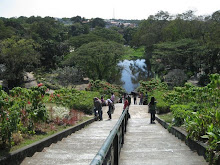Monday, August 22, 2011
traditional filipino folk dance
Most Philippine dances were originally patterned after European dances during the Spanish regime. Pandango Sa Ilaw, Cariñosa, Rigodon and Balitao are examples of these dances Filipinos are known for. Aside from these western-influenced dances, ethnic-created dances such as Tinikling made its way to nationwide recognition. Despite its apparent adaptation to western dances, still Filipinos pay tribute to their cultural roots. Every district in the islands has its own folk dance, interpreted attractively in festivals and local shows, which have added to the country’s reputed contribution to world’s illustration of traditional arts.
The following are examples of popular Philippine folk dances :
Binasuan - Binasuan originated in Pangasinan Province “meaning with the use of drinking glasses”, this vibrant dance basically shows off balancing skill of the performers. Glasses filled with rice wine are placed on the head and on each hand carefully maneuvered with graceful movements. This dance is common in weddings, fiestas and special occasions.
Rigodon - Originated from Spain, this dance is commonly performed at formal affairs like inaugural balls where prominent members of the government participate and enjoy.
Pandanggo sa Ilaw - The word pandanggo comes from the Spanish dance “fandango”characterized with lively steps and clapping while following a varying ¾ beat. Pandanggo requires excellent balancing skill to maintain the stability of three tinggoy, or oil lamps, placed on head and at the back of each hand. This famous dance of grace and balance originated from Lubang Island, Mindoro.
Tinikling - Tinnikling is considered the national folkdance with a pair of dancers hopping between two bamboo poles held just above the ground and struck together in time to music. Originated from Leyte Province, this dance is in fact a mimic movement of “tikling birds” hopping over trees, grass stems or over bamboo traps set by farmers. Dancers perform this dance with remarkable grace and speed jumping between bamboo poles.
Maglalatik - Originally performed in Binan, Laguna as a mock-war dance that demonstrates a fight between the Moros and the Christians over the prized latik or coconut meat during the Spanish rule, this dance is also shown to pay tribute to the town’s patron saint, San Isidro Labrador. It has a four-part performance such as the palipasan and the baligtaran showing the intense battle, the paseo and the escaramusa- the reconciliation. Moro dancers wear read trousers while the Christian dancers show up in blue. All dancers are male ; with harnesses of coconut shells attached on their chests, backs, thighs and hips.
Cariñosa - Cariñosa is a word that describes an affectionate, friendly and lovable woman. This dance is performed in flirtatious manner with fans and handkerchiefs to assist the dancers’ hide-and-seek movements.
La Jota Manileña - It is a dance named after the capital city of the Philippines, Manila, where an adaptation of Castilian Jota afloats with the clacking of bamboo castanets played by the dancers themselves. The costume and the graceful movements of the performers noticeably inspired by Spanish Culture.
Source: http://www.camperspoint.com

















1 comment:
great site you had. I added you in my site, pls do the same for me, thanks a lot.
Post a Comment